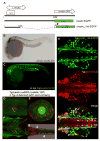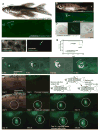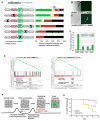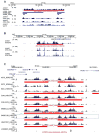A zebrafish melanoma model reveals emergence of neural crest identity during melanoma initiation
- PMID: 26823433
- PMCID: PMC4868069
- DOI: 10.1126/science.aad2197
A zebrafish melanoma model reveals emergence of neural crest identity during melanoma initiation
Abstract
The "cancerized field" concept posits that cancer-prone cells in a given tissue share an oncogenic mutation, but only discreet clones within the field initiate tumors. Most benign nevi carry oncogenic BRAF(V600E) mutations but rarely become melanoma. The zebrafish crestin gene is expressed embryonically in neural crest progenitors (NCPs) and specifically reexpressed in melanoma. Live imaging of transgenic zebrafish crestin reporters shows that within a cancerized field (BRAF(V600E)-mutant; p53-deficient), a single melanocyte reactivates the NCP state, revealing a fate change at melanoma initiation in this model. NCP transcription factors, including sox10, regulate crestin expression. Forced sox10 overexpression in melanocytes accelerated melanoma formation, which is consistent with activation of NCP genes and super-enhancers leading to melanoma. Our work highlights NCP state reemergence as a key event in melanoma initiation.
Copyright © 2016, American Association for the Advancement of Science.
Figures





Comment in
-
CANCER. Tracking the origins of tumorigenesis.Science. 2016 Jan 29;351(6272):453-4. doi: 10.1126/science.aad9670. Science. 2016. PMID: 26823415 No abstract available.
References
-
- Slaughter DP, Southwick HW, Smejkal W. Field cancerization in oral stratified squamous epithelium; clinical implications of multicentric origin. Cancer. 1953;6:963–968. - PubMed
-
- Mort RL, Jackson IJ, Patton EE. The melanocyte lineage in development and disease. nrs.harvard.edu. - PubMed
-
- Patton EE, et al. BRAF Mutations Are Sufficient to Promote Nevi Formation and Cooperate with p53 in the Genesis of Melanoma. Current Biology. 2005;15:249–254. - PubMed
Publication types
MeSH terms
Substances
Associated data
- Actions
Grants and funding
LinkOut - more resources
Full Text Sources
Other Literature Sources
Medical
Molecular Biology Databases
Research Materials
Miscellaneous

